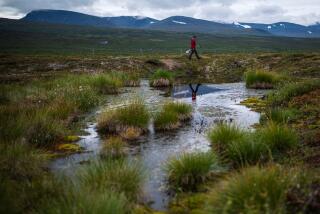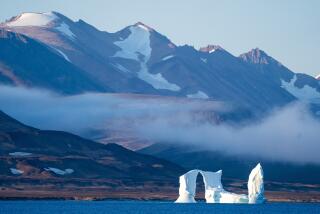Global Climate Shift Seen in Polar Ice Melt
SAN FRANCISCO â Ice in the Arctic Ocean and on Greenlandâs massive icecap shrank to record levels this summer, providing more evidence that global warming is causing unprecedented environmental change that is alarming seasoned climate-watchers.
âI was really surprised by this,â said Mark Serreze, a polar researcher at the National Snow and Ice Data Center in Boulder, Colo., who announced the findings Saturday at a meeting of scientists here. âThis was the craziest summer Iâve seen up there.â
The news comes at a time when researchers are becoming increasingly concerned about abrupt climate change. In the geological past, rapid changes linked to global warming and the melting of polar ice have resulted in century-long droughts and sea level increases that could cripple many of todayâs low-lying cities.
âIf we do nothing, warming in the next 150 years could be enough to melt the Greenland ice sheet, causing a 3- to 6-meter [about 10-foot to 20-foot] sea level rise that could be catastrophic,â said Jonathan Overpeck, an expert on past climates at the University of Arizona.
Arctic sea ice is at its minimum in September, at the end of the summer. At that time, ice normally covers 2.4 million square miles of ocean north of Greenland, Russia and Canada. This summer, ice covered just 2 million square miles and was extremely thin in many regions, said Ted Scambos of the Colorado data center. Itâs the lowest seen since scientists began closely monitoring the Arctic by satellite 24 years ago, Serreze said, and is probably a record for the last 50 years. Historical records kept by fishermen in Iceland are spotty, but suggest that Arctic sea ice has not been so low for centuries, he added.
The icecap on Greenland, the second-largest mass of frozen freshwater in the world after Antarctica, also broke all records for melting this summer. Satellites recorded melting across nearly 265,000 square miles of the icecap, which is about the size of Texas.
Melting occurred even on the islandâs northernmost reaches and to elevations as high as 6,560 feet that are normally too cold to melt. There was so much flooding at the surface that glaciologist Konrad Steffen of the University of Colorado had to be evacuated by helicopter in June. His camp was under more than a foot of water, said Steffen, who plans to start next yearâs field season a month early to avoid flooding.
The 14,000-foot-thick Greenland icecap has thinned several feet per year in some areas, he said. This is not caused directly by the melting, but by water that seeps through crevasses to the bottom of the ice and then helps the ice flow more quickly to the sea, where it breaks off as icebergs that eventually melt.
The dramatic loss of ice in the Arctic Ocean and Greenland, coupled with other new work showing the rise of trees and shrubs across once-barren Arctic tundra lands, âpresents a compelling case that something is changing very rapidly over a wide area,â said Larry Hinzman, an expert in Arctic change at the University of Alaska at Fairbanks.
Oceanographers who study the region are seeing changes in the water beneath the ice as well. Salinity and temperature are starting to shift, suggesting that the ocean may be circulating differently, said James Morison, an oceanographer at the University of Washingtonâs Polar Science Center.
Even subtle changes can dramatically effect the oceansâ largest currents.
The most dramatic of these is a reversal of the Gulf Stream, which normally warms Europe by about 10 degrees Fahrenheit but stopped abruptly 11,000 years ago, leading to a mini Ice Age for the area.
Scientists here are trying to understand exactly what is causing these changes. Many studies suggest that greenhouse gases produced by industrial activity are to blame for about half of the roughly 2-degree warming of the planet seen in recent decades, and natural factors are blamed for the other half.
The Arctic sea ice is influenced dramatically by a decades-long cycle called the âArctic oscillation,â which varies between a phase that leaves much of the Arctic cold and still and one that leaves it warm and windy. Though the phases alternate normally every decade or so, the Arctic has stayed locked in the warm and windy phase since the 1980s, Serreze said.
Serreze blames the warm stretch and its many storms for the lack of sea ice. But that doesnât mean that he pins the changes on Mother Nature alone.
A growing body of research suggests that human pollutants, including ozone-destroying chemicals and greenhouse gases, are responsible for keeping the Arctic oscillation locked in the warmer mode, he said. Environmental groups and many foreign nations are criticizing U.S. leaders for not taking action to reduce the output of greenhouse gases.
President Bush convened a summit on global warming in Washington last week, but said that the issue needed to be researched further before any implementation of potentially costly rules.
With Arctic ice so dramatically on the wane, many scientists here remained skeptical of that policy. âAs a scientist, I certainly advocate continued research,â Serreze said.
âBut the longer we wait, the longer we procrastinate, and the bigger our problems will be in the future.â
More to Read
Sign up for Essential California
The most important California stories and recommendations in your inbox every morning.
You may occasionally receive promotional content from the Los Angeles Times.










